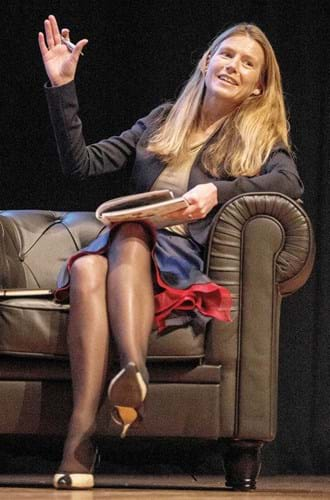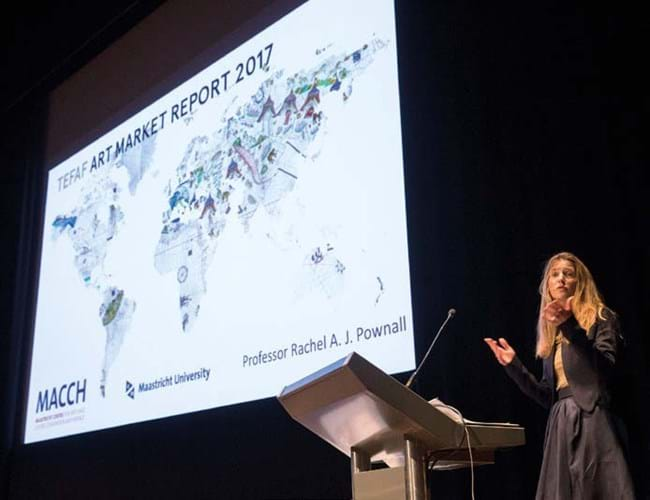Since its launch in 2002 the TEFAF Art Market Report has established itself as the art and antiques trade’s key annual barometer of size and trends. While the report has grown in scope, recording the market’s ebbs and flows, it has rarely delivered seismic shocks.
All this changed earlier this month when the latest report valued the global art market at $45bn – well below the $63bn the 2016 survey estimated it to be.
The reason for such a sharp correction was not due to a market meltdown – though it did soften – but because the TEFAF organisation had created a new way to measure the market, as the previous data is the copyright of former author Dr Clare McAndrew.
The report reinvention task fell to its new helmswoman, Devonborn Professor Rachel Pownall of Maastricht University, who replaced McAndrew after the latter left to join the Art Basel group in 2016.
The resulting cut in the global art market’s size by a third raised eyebrows, as did dramatically reduced auction figures for the two largest single markets, the US and the UK.
But as ATG met Pownall at TEFAF this month and listened to her present the report’s findings to 300 fair delegates, it was clear the academic is not phased by those who question the reliability of her debut TEFAF report.
ATG: Was it your intention to start from scratch, or ‘reset the dial’ so to speak, with your first TEFAF report?
RP: I wasn’t intending to reset the dial – it was a good and credible report previously. Consistency is vital. I wanted to build upon the previous art market reports commissioned by TEFAF.
For consistency we decided to maintain the global stance, giving an estimate of world sales during 2016 and how that has changed over the year. We found the market had grown by 1.7%.
The focus in the past was very much on auction sales data, and my first impression, when asked to prepare this report, is that the voice of the dealer should also be heard.
So were earlier TEFAF reports too auction-orientated in your opinion?
There was so much on auction houses previously. It was such a large part of the report, because the data is easily available. In contrast, dealer data has traditionally been opaque.
Perhaps the biggest surprise of the 2017 report was the drop in size of the global market – from $63bn to $45bn.
How do you account for this difference?
I believed it was prudent to reassess the market but not to discredit the past. Previously [the report’s research] was very broad and I decided instead to concentrate on the art and antiques market.
We asked what is a ‘collectable’? If it’s something sold by an antiques dealer, then we included the sale in the data; if it is sold at a second-hand shop or a flea market, the sale was not included in the numbers. We focused on auction sales of items above $500.
Why this $500 cut-off point?
We are trying as best as possible to reflect the type of trade at fairs like TEFAF and at art and antiques auctions.
The size of the dealer segment in the report, with dealer sales accounting for 62.5% of global art sales, has been questioned. Have you over-estimated this part of the market?
This report is not skewed to dealers: it is about taking a more balanced approach. We wanted to give a voice to the dealer sector which represents at least half of the market.
To give a balanced view between auction houses and dealers meant going beyond a dealer survey to draw my conclusions. Gauging the current size and state of the market involved retrieving additional data from offices for national statistics [for each country] as well as private financial databases for thousands of dealers.
Were you encouraged by TEFAF to boost the report’s representation of dealers?
TEFAF did not encourage me to focus on anything in particular. I was given the utmost independence and freedom to write and source for the report as I wished.
It was my own findings, resulting in the role of the dealer showing significant growth since 2012. This is not a shift this year only, but a growing trend that has not received sufficient attention until this year.
Overall, how confident are you about the report’s dealer data? We see you narrowed the definition of what an art and antiques dealer is.
We surveyed a smaller number of art and antiques dealers than before but I am confident it is the right size of the market.
We are able to narrow down the type of dealers we analysed. The advantage of my university role is that we have access to the breakdown of industry categories and definitions.
This enabled us to search thousands of sources including financial databases in a narrower and more relevant way.
We looked at company accounts of many dealers including large ones such as Gagosian Gallery, David Zwirner and The Pace Gallery and created a global sample to analyse.
Around 20% of dealers in Europe made a loss, but this is mainly the smaller sole-trader businesses, while the larger dealers are growing.
The top-end dealers such as Pace, Zwirner, Hauser & Wirth Gallery and Gagosian, those with many employees, are much more likely to be making a profit.
The 2017 report has auction sales in the UK falling by a quarter (24%), a finding that conflicts with data from other sources.
The data reflects a decline at the very top end. The volume of high-end auctions and the number of lots sold in the UK, and particularly in the US, have dropped significantly.
However, prices have been maintained and at the mid and lower end, volumes have not changed much.
In the UK, post-war, modern and contemporary average prices were down [due to the fall in the volume of consignments] while antiques were roughly the same and jewellery was up.
The report resizes the US share of the global art market at 29.3% from 43% (2016) of total art market sales. Why such a significant drop?
It is important to note the reduced role of the traditional top three countries. The US, UK and China are all losing market share to the rest of the world.
I think the reduction in market share is a combination of both economic uncertainty and increased wealth of other nations.
Also to consider is the reduction in guarantees for high-end artworks given by auction houses last year.
This reduces the position of auction houses and is to the advantage of dealers, as the risk of not selling remains with the seller.
Burning an artwork publicly at auction is detrimental to the long-term resale potential of the artwork, which makes the privacy of the dealer market more attractive [as artworks offered for sale are not in the wider public domain].
Curriculum Vitae
1996
BA First Class Honours Degree in Economics & Econometrics (German) at University of Kent at Canterbury, UK
1999 - 2001
PhD at Maastricht University and Erasmus University, Rotterdam
2002 - 2014
Assistant and associate professor roles at Tilburg University and Maastricht University
2015 - Present
Professor of Arts Finance & Museum Management at TIAS School for Business and Society
2016 - Present
TEFAF Professor of Arts Markets, School of Business and Economics, Maastricht University















